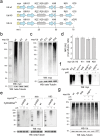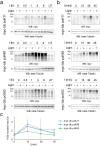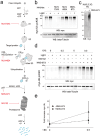Light-Activatable Ubiquitin for Studying Linkage-Specific Ubiquitin Chain Formation Kinetics
- PMID: 39716962
- PMCID: PMC11809417
- DOI: 10.1002/advs.202406570
Light-Activatable Ubiquitin for Studying Linkage-Specific Ubiquitin Chain Formation Kinetics
Abstract
Ubiquitination is a dynamic post-translational modification governing protein abundance, function, and localization in eukaryotes. The Ubiquitin protein is conjugated to lysine residues of target proteins, but can also repeatedly be ubiquitinated itself, giving rise to a complex code of ubiquitin chains with different linkage types. To enable studying the cellular dynamics of linkage-specific ubiquitination, light-activatable polyubiquitin chain formation is reported here. By incorporating a photocaged lysine at specific sites within ubiquitin through amber codon suppression, light-dependent activation of ubiquitin chain extension is enabled for the monitoring of linkage-specific polyubiquitination. The studies reveal rapid, minute-scale ubiquitination kinetics for K11, K48, and K63 linkages. The role of individual components of the ubiquitin-proteasome system in K48-initiated chain synthesis is further studied by small molecule inhibition. The approach expands current perturbation strategies with the ability to control linkage-specific ubiquitination with high temporal resolution and should find broad application for studying ubiquitinome dynamics.
Keywords: genetic code expansion; optochemical biology; small molecule inhibitors; ubiquitin.
© 2024 The Author(s). Advanced Science published by Wiley‐VCH GmbH.
Conflict of interest statement
The authors declare no conflict of interest.
Figures




Similar articles
-
UbiREAD deciphers proteasomal degradation code of homotypic and branched K48 and K63 ubiquitin chains.Mol Cell. 2025 Apr 3;85(7):1467-1476.e6. doi: 10.1016/j.molcel.2025.02.021. Epub 2025 Mar 24. Mol Cell. 2025. PMID: 40132582 Free PMC article.
-
Proteasome-independent functions of lysine-63 polyubiquitination in plants.New Phytol. 2018 Feb;217(3):995-1011. doi: 10.1111/nph.14915. Epub 2017 Nov 30. New Phytol. 2018. PMID: 29194634 Review.
-
The K48-K63 Branched Ubiquitin Chain Regulates NF-κB Signaling.Mol Cell. 2016 Oct 20;64(2):251-266. doi: 10.1016/j.molcel.2016.09.014. Epub 2016 Oct 13. Mol Cell. 2016. PMID: 27746020
-
The recognition of ubiquitinated proteins by the proteasome.Cell Mol Life Sci. 2016 Sep;73(18):3497-506. doi: 10.1007/s00018-016-2255-5. Epub 2016 May 2. Cell Mol Life Sci. 2016. PMID: 27137187 Free PMC article. Review.
-
K63 ubiquitylation triggers proteasomal degradation by seeding branched ubiquitin chains.Proc Natl Acad Sci U S A. 2018 Feb 13;115(7):E1401-E1408. doi: 10.1073/pnas.1716673115. Epub 2018 Jan 29. Proc Natl Acad Sci U S A. 2018. PMID: 29378950 Free PMC article.
Cited by
-
From exposure to innovation: decoding aromatic amines' role in bladder cancer mechanisms.Discov Oncol. 2025 May 23;16(1):888. doi: 10.1007/s12672-025-02730-w. Discov Oncol. 2025. PMID: 40410554 Free PMC article.
-
Emerging tools and methods to study cell signalling mediated by branched ubiquitin chains.Biochem Soc Trans. 2025 Jun 30;53(3):579-592. doi: 10.1042/BST20253015. Biochem Soc Trans. 2025. PMID: 40380883 Free PMC article. Review.
References
MeSH terms
Substances
Grants and funding
LinkOut - more resources
Full Text Sources
